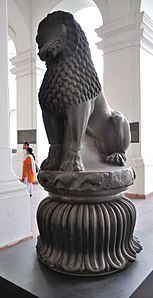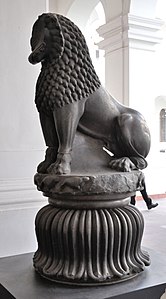Rampurva capitals
 Original bull capital of Rampurva, one of the Pillars of Ashoka, now located in the Presidential Palace of Rashtrapati Bhavan, New Delhi. 3rd century BCE. | |
| Location | West Champaran district, Bihar, India. |
|---|---|
| Coordinates | 27°16′11.75″N 84°29′58.08″E / 27.2699306°N 84.4994667°E |
| Type | Settlement |
The Rampurva capitals are the capitals of a pair of Ashoka Pillars discovered in c. 1876 by A. C. L. Carlleyle.[1][2] The archaeological site is called Rampurva, and is located in the West Champaran district of the Indian state of Bihar, situated very close to the border with Nepal.[3] The lion capital is now in the Indian Museum in Kolkota, while the bull capital is located at the center of the porch of the Rashtrapati Bhavan, the Indian Presidential Palace.
Buddhist significance[edit]
Waddell in 1896 suggested that the death or parinirvana of Gautama Buddha was in the region of Rampurva: "I believe that Kusīnagara, where the Buddha died may be ultimately found to the North of Bettiah, and in the line of the Açōka pillars which lead hither from Patna (Pāțaliputra)."[4] Modern scholarship, based on archaeological evidence, believes that the Buddha died in Kushinagar (Uttar Pradesh).[5][6][7]
Rampurava lion capital[edit]

The lion pillar is inscribed with the Major Pillar Edicts of the Edicts of Ashoka, Pillar Edicts I, II, III, IV, V, VI.[8]
Rampurva bull capital[edit]
The Rampurva bull capital is noted as one of the seven remaining animal capitals from the Pillars of Ashoka. It is composed of a lotiform base, with an abacus decorated with floral designs, and the realistic depiction of a zebu bull.
The abacus in particular displays a strong influence of Greek art: it is composed of honeysuckles alternated with stylized palmettes and small rosettes.[9] A similar kind of capital can be seen at the basis of the Sankassa elephant capital. A similar frieze is also visible on the Diamond throne built by Ashoka at Bodh Gaya. These design likely originated in Greek and Near-Eastern arts.[10]
The bull is without inscriptions, presumably because its twin pillar, the Rampurava lion pillar already had them and therefore there was no need to repeat.[8] It is thought that the bull symbol is not related to the bull Nandi of Hinduism, as Ashoka was quite eclectic in his choice of animals for his pillars anyway: lions, elephants, camels, geese, and horses are known.[8]
-
Rampurva pillar excavation 1877.
-
Remains of the pillars today.
-
Original Rampurva bull up the stairs of Rashtrapati Bhavan, New Delhi.
| Rampurva capitals | |
| Lion capital |
|
| Bull capital |
|
See also[edit]
References[edit]
- ^ "Rampurva". Encyclopædia Britannica. Retrieved 7 October 2014.
- ^ Allen, Charles (2010). The Buddha and Dr. Führer: An Archaeological Scandal. Penguin Books India. pp. 66–67. ISBN 978-0143415749.
- ^ "Rampurva". Bihar Tourism. Retrieved 7 October 2014.
- ^ "A Tibetan Guide-book to the Lost Sites of the Buddha's Birth and Death", L. A. Waddell. Journal of the Asiatic Society of Bengal, 1896, p. 279.
- ^ United Nations (2003). Promotion of Buddhist Tourism Circuits in Selected Asian Countries. United Nations Publications. pp. 23–24. ISBN 978-92-1-120386-8.
- ^ Kevin Trainor (2004). Buddhism: The Illustrated Guide. Oxford University Press. p. 41. ISBN 978-0-19-517398-7.
- ^ Elizabeth Lyons; Heather Peters; Chʻeng-mei Chang (1985). Buddhism: History and Diversity of a Great Tradition. University of Pennsylvania Museum of Archaeology. p. 17. ISBN 978-0-934718-76-9.;
Fred S. Kleiner (2009). Gardner's Art through the Ages: Non-Western Perspectives. Cengage. pp. 13, 31. ISBN 978-0-495-57367-8. - ^ a b c Buddhist architecture, Huu Phuoc Le, Grafikol, 2010 p.36-40
- ^ "Buddhist Architecture" by Huu Phuoc Le, Grafikol, 2010, p.40
- ^ "Buddhist Architecture" by Huu Phuoc Le, Grafikol, 2010, p.44 [1]
















